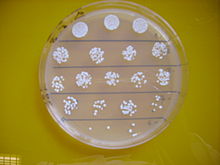- Brettanomyces bruxellensis
-
Brettanomyces bruxellensis Scientific classification Kingdom: Fungi Phylum: Ascomycota Subphylum: Saccharomycotina Class: Saccharomycetes Order: Saccharomycetales Family: Pichiaceae Genus: Brettanomyces Species: B. bruxellensis Binomial name Brettanomyces bruxellensis
Kufferath and von LaerBrettanomyces bruxellensis (the anamorph of Dekkera bruxellensis) is a yeast native to the Senne valley near Brussels, Belgium. It is one of several members of the genus, which was discovered at the Carlsberg brewery in 1904 by N. Hjelte Claussen, who was investigating it as a cause of spoilage in English ales, hence the name. In the wild, it lives on the skins of fruit.
Contents
Beer production
Brettanomyces bruxellensis plays a key role in the spontaneous fermentation of typical Belgian beer styles such as Lambic, Flanders red ales, Gueuze, and Kriek. It competes with brewer's yeast, as well as other microorganisms, in fermenting the wort, and gives the beer a distinctive taste, which is a desired part of the style.
Wine production
In the wine industry, Brettanomyces bruxellensis is generally considered a spoilage yeast and is often referred to as brett. Its metabolic products can impart "sweaty saddle leather", "barnyard", "burnt plastic" or "band-aid" aromas to wine. Some winemakers in France, and occasionally elsewhere, consider it a desirable addition to wine, e.g., in Château de Beaucastel, but New World vintners generally consider it a defect. Some authorities consider brett to be responsible for 90% of the spoilage problems in premium red wines.
One defense against brett is to limit potential sources of contamination. It occurs more commonly in some vineyards than others, so producers can avoid purchasing grapes from such sources. Used wine barrels purchased from other vintners are another common source. Some producers sanitize used barrels with ozone. Others steam or soak them for many hours in very hot water, or wash them with either citric acid or peroxycarbonate.
If wine becomes contaminated by brett, some vintners sterile filter it, add SO2, or treat it with dimethyl dicarbonate. Both knowledge and experience are considered helpful in avoiding brett and the problems it can cause.
Biochemistry
B. bruxellensis contains the enzyme vinylphenol reductase.
See also
References
- "Breaking the mold", Wine Spectator,2006 (March 31), 30(16), pp. 99–100 & 103.
- Wild Brews: Beer Beyond the Influence of Brewer's Yeast, Jeff Sparrow, Brewers Publications, Coulder, Colo., 2005
Categories:- Yeasts
- Oenology
- Grape diseases
- Yeasts used in brewing
- Saccharomycetes
Wikimedia Foundation. 2010.

